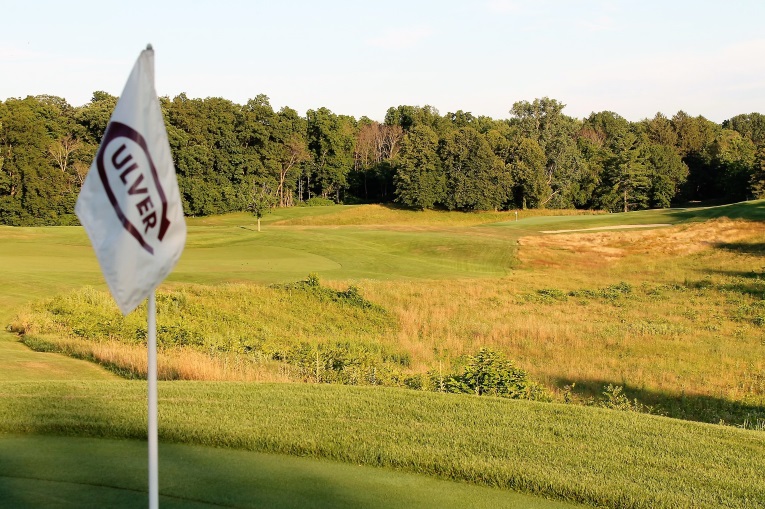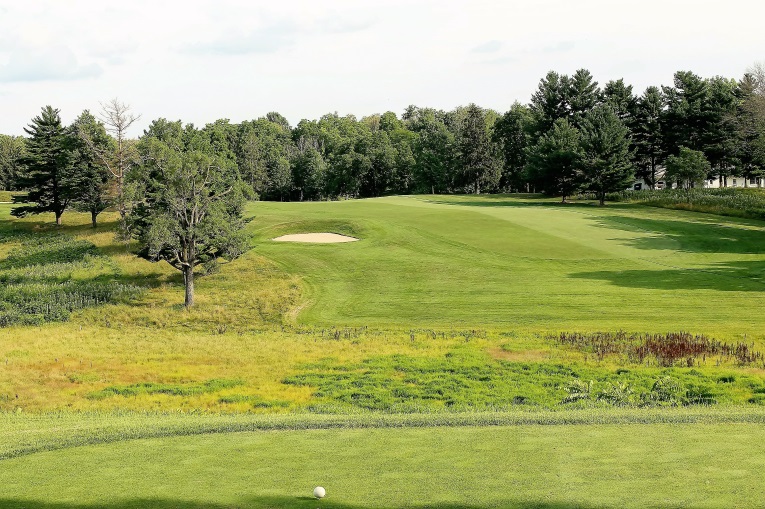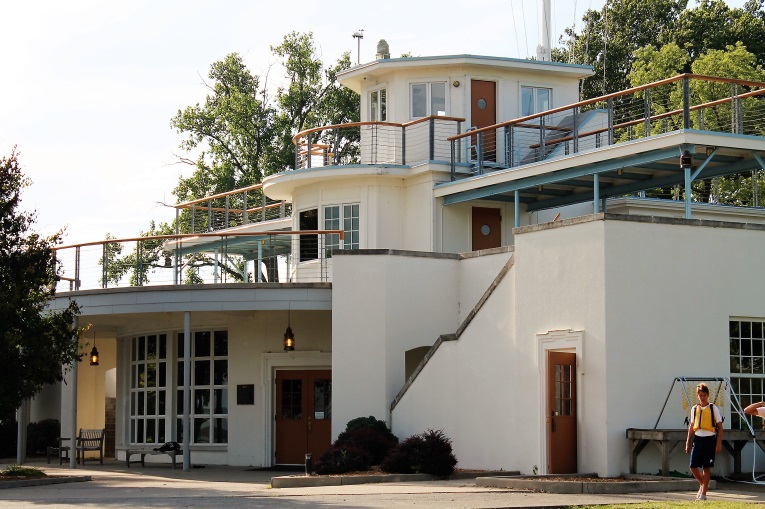Culver Academies Golf Course
Indiana, United States of America
GolfClubAtlas.com takes immense pride and even joy in this 2016 updated review of arguably the finest nine hole course in North America. When I first visited the course in 2006, that was not the case but because of a first rate restoration in 2013/14 and the engagement of Culver Academies and its alumni, few courses – nine or eighteen – can compete with it for fun and fascination.
The story begins in 1922 when the prestigious Culver Academies contacted the firm of Langford & Moreau to inspect 250 acres near their campus. The property was a mix of woodland, orchards and pasture. Dramatic in part, the property also afforded views over Lake Maxinkuckee, the second largest lake in Indiana. Langford & Moreau liked the landforms and their potential so much that they developed a plan for 27 holes linked to a nearby inn. Though this was the roaring twenties and the owners of the Academy, Edwin and Bertram Culver, wanted first class golf brought to the area, it was decided to take a measured approach. They asked Langford & Moreau to focus first on nine holes and to forgo connection with the inn.
Construction began on the center of the property in the fall of 1922 and nine holes opened for play in late spring of 1924. Eight years later the Culver family earnestly considered the construction of a second nine holes from Langford & Moreau’s original 27 hole routing but the breadth and depth of the Great Depression ended such thoughts. During World War II the bunkers weren’t tended to and ultimately were all grassed. Also, at that time, mowing restrictions gradually reduced the size of the putting surfaces.
Nonetheless, the course still retained a fan base and based on word of mouth, Ted Sturges and I toured the Culver course in 2006. We are both unabashed devotees of the C.B. Macdonald school of architecture and his disciples including Langford & Moreau. Even without sand in the bunkers and drastically shrunken greens (and therefore diminished interest), Langford & Moreau’s indomitable architecture shined through. Only two people tended the course back then under the general grounds maintenance budget of the Academy. Given that the course had no irrigation, upkeep consisted primarily of mowing the playing areas and hand watering the tees and greens. The greens stimped around 6.
Ted and I left mesmerized though torn. How were we expected to love the course if the school didn’t? I later wrote in the GCA profile, ‘The Culver Family and Langford & Moreau did their part in building one of the great courses and bringing golf to this part of the country. Hopefully, consideration will be given to restoring some or all of the features to this marvelous nine hole course. Just as the Academy itself is one of the great institutions in education, so too this golf course is one of the great designs and deserves to be acknowledged and treated accordingly.’
WELL! That could have been that. Happily, it wasn’t. Several months later, a man named Jim Henderson rang me from southern Indiana. Unfailingly polite, he nonetheless asked a series of pointed questions about the profile and the points it raised. I gleaned from subsequent phone calls the following year with Jim that he and Greg ‘Barney’ Poole (class of ’53) who first put forth the idea of restoring the course had along with some knowledgeable golf alumni established a genuine interest for seeing this 76 acre work of art restored to the caliber of the other school facilities. The current Board Chair Miles D. White (class of ’73), an avid golfer, was a keen advocate, which is exactly what the course needed.

No half measures on the campus of Culver. In the background is the Culver Legion Memorial building for those alumni that gave their life in World War I and in the foreground is the Centennial Eagle given by a Texas alumnus in 1994. How could such a place countenance a diminished golf course? Answer: It couldn’t.
What I didn’t know or appreciate at the time was that Jim Henderson (class of ’52) was the Chairman Emeritus of the Board of Trustees for Culver Academies. He had warm memories of playing the course with his father (who started as the Chaplain and became the Dean of Admissions over 61 years of service at the school) and his two older brothers. Having grown-up experiencing just how much fun this nine holer is to play, he happily reached out and culled support from key alumni.
Simultaneously, two North Carolina alumni, Stuart Dickson (class of ’47) and Greg Poole reached out to Bobby Weed. All three men enjoyed a Linville, North Carolina connection and eventually flew out to tour the course. On the first visit, four inches of snow fell the night before, making things a bit challenging. Bobby returned in the spring of 2009 to more favorable conditions. As he puts it, ‘I felt like I had opened up a barn door and found a vintage Porsche 356 underneath dust and hay. How could you not respect what was there?!’
Weed instantly grasped that the school had a new found appreciation for what they had and were after a pure restoration. This was by no means to be a renovation or an interpretation but rather a strict call to restore the audacious features with which Langford & Moreau had imbued the property. A few back tees suggested themselves and pushed the nine holes to 3,230 yards. Nothing else was required, which was plenty fine with both the school and Bobby.
This project also happened to dovetail perfectly with one of Bobby’s beliefs, namely that nine hole courses have a real place in the game. Having clamored for more nine holers for well over a decade (long before it became fashionable to do so), he was frustrated because the ones that exist tend to be on poor land or offer uninteresting holes or are poorly maintained. He correctly saw that properly restored, this course would stimulate and generate much greater interest in nine holers going forward. He even reached out to Ron Whitten and suggested that Golf Digest rank the top 50 nine holers in the country, just to help give them added credence.

This 1939 aerial served as the bench mark for the Weed restoration. The dogleg left 1st is seen in the lower left of the photograph, followed by the two heavily bunkered one shotters in opposite directions, the great dogleg left 4th, then up to the 5th. The 6th is in the top right of the photograph while the 7th heads into the property’s wooded portion. The 8th is the sole hole played entirely in trees and the 9th emerges from the forest and provides a roller-coaster finish across two valleys.
Work commenced in the fall of 2013, starting with the installation of a single row irrigation system (the first in the course’s history). That winter, unchecked tree growth was peeled back to reveal the intoxicating land forms seen throughout this profile. Holes 7-9 play into and then out of the forested portion of the property but otherwise, long views have always helped to define a game here. 2014 saw the brunt of the work tackled. Additionally, Tom Mead was brought in to help begin the process of establishing playing conditions conducive to good golf. Chris Monti from Bobby Weed’s office was the on-site man and oversaw the work whereby the bunkers were brought back in 3-D (!) and the greens were expanded from a total of 40,000 square feet to 54,000 square feet, an increase of 35%.
At this point in the summer of 2014, the school set about hiring a full time Green Keeper. At the time, Mike Vessely was working as Assistant Green Keeper at the Hurdzan & Fry designed Black Thorn in South Bend about one hour to the north. When he came to visit in the fall, the vast majority of the work was complete and he promptly fell under the course’s spell. According to Mike, once he started,
My biggest challenge was to improve the putting surfaces. As one might expect from surfaces that had not been properly cared for several decades, they were as soft as a mattress and the expanded areas were of course thin and ugly. The most important thing they needed was sand, sand and then more sand. When I took the position in November, 2014 I started that process right away. I sanded three times before winter set in, including burying them before the snow. We had a mild winter and I was actually able to do a lot of dormant seeding and sanding on the expansion areas. I have sanded the greens every week since May of 2015 and have built a 2 inch layer of sand beneath the crowns. Things are considerably firmer, faster and drain much better. To get the ‘old’ and ‘new’ putting surfaces to meld together, I called on the help of a friend and local Superintendent Scott Lippens and borrowed a walk behind greens mower. He very kindly let us use it for as long as we needed. We continued mowing the good parts of our greens with the triplex but I let the expanded areas grow to about 1/2 inch before I started to mow them with the walk mower. Eventually, I lowered the height on the walk mower every 7 days by 30,000th of an inch. By July, 2015 we started mowing all the putting surfaces at our greens height. The sanding has continued ever since and we have brought the greens from a 5.5 on the stimp to 9.5. We have also added vertical mowing, venting, and deep tine aeration to the process. I am proud to say that these greens, which have some of the best internal contours I have ever seen, are definitely getting the love they deserve.
Mike touches on an important point: all the features, from the green contours to the pronounced bunker walls, had been perfectly preserved over the years. While they weren’t presented properly, the course suffered from neglect as opposed to other Golden Age course that have seen ponds added and holes altered. Langford & Moreau’s features are so unambiguous that an experienced architect like Weed quickly and easily soused out what was required to re-establish the scale of their bunkers and greens. Just as important, Weed recovered fairway width which re-introduced the playing nuances to the design. All the high slopes that feed on to the greens (e.g. left of the 1st, right at the 2nd, right at the 4th, left at the 9th) are once again fairway height, which allows the ground game to blossom again at Culver.
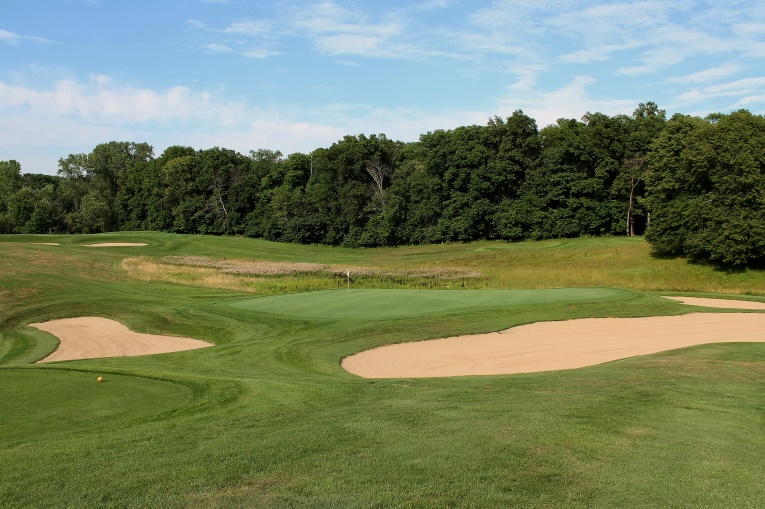
Langford & Moreau spread 36 bunkers across the original nine holes and Bobby Weed gave the school wise counsel when he insisted that each one be restored. This view is across the 3rd green with the 2nd green in the distance – the two par 3s combine for 11 of the bunkers!
Chris Monti succinctly sums up the project:
The restoration of Culver Academies’ course was easily the most archeological project that Bobby and I have completed. Marking the limits of the bunkers and putting surfaces – 1939 aerial in one hand and paint gun in the other – was a genuine thrill. But ultimately, the more meaningful aspect of the project for me was helping evolve the school’s approach to the golf course. From a golf architecture perspective, the merits of a restoration were obvious. But Culver’s mission is not centered on what’s best for golf course architecture. The project had to advance the Academies’ educational purpose, which focuses on developing the whole student: Mind, Body, and Spirit. Offering an authentic golf experience would allow Culver to use the game to develop character and instill values that enhance these three cornerstones. But this wasn’t possible with the course in its un-restored state, as the layout didn’t provide an enticing experience that motivated the student’s use of the course. Once the project’s benefactors and school administrators recognized this dynamic, the commitment was immediate. They concurred that the key to providing authenticity was a strict restoration of Langford and Moreau’s work, and thus the interests of the Academies and the discipline of golf design became aligned. Knowing what the course was (and could be), Bobby and I didn’t want the project to proceed if it was a half-effort, while the Academy understandably wanted to be sure of its footing before jumping in completely. Today, nowhere is their newfound commitment more evident than in Mike Vessely’s presence. His is a newly created position, and I don’t know of another prep school with a dedicated turf professional on-staff. Mike is a testament to how completely the school has embraced its role as the steward of this creative masterwork.
The end results of this strict restoration speak for themselves, as we see below.
Holes to Note
First hole, 505 yards, (10th); The property that the golf course occupies can be accurately termed ‘rambunctious’. Yet so skillful is Langford’s routing that every hole fits in well without a single one fighting the terrain. No telling what routing a lesser architect might have devised. On the most abrupt piece of the property, Langford positioned the tee exhilaratingly on top of a sharp sixty foot drop affording magnificent views of Lake Maxinkuckee, just three hundred yards away on the right. Today, only glimpses of the lake are available through the trees but the golfer’s focus is captured by the task at hand. In this case, the crescent shaped fairway bends left past two formidable bunkers, the second of which protects the best/shortest path to the green. If the golfer can carry it (the sand is actually at grade, it’s just that the mound beyond was built-up eight feet!) by thirty yards, his ball will take the left to right cant of the fairway and tumble some 80 yards downhill to the open green – a classic risk-reward conundrum.
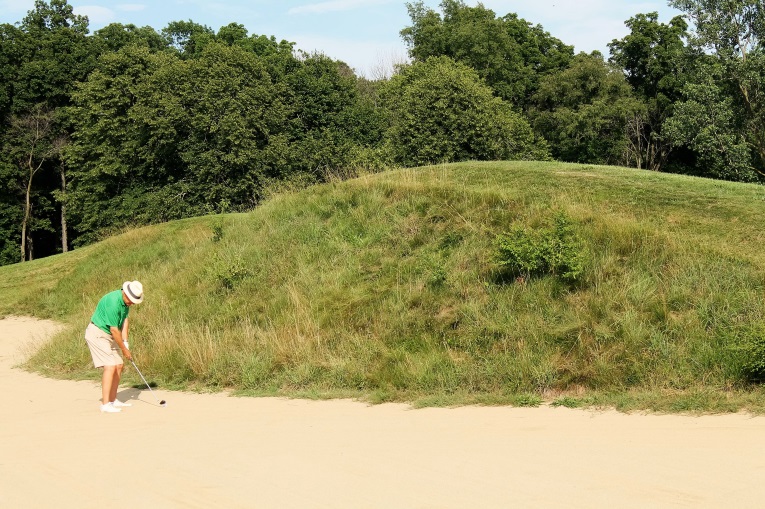
Alas, this six foot two inch tall gentleman’s second shot didn’t quite clear the bunker built near the crest of a hill. If it had, it could have bounded all the way …

… onto the green below. Note how Bobby Weed optimized the mow lines. The turf left was maintained as a rough for several decades which precluded the ball from releasing down the slope and onto the green as Langford intended.
Second hole, 180 yards (11th); This stunningly manufactured green site is full of great Redan characteristics including the prerequisite high right front slope that gives way to a green that angles to the back left. A unique twist occurs within the putting surface where a central mound actually diverts balls back right as opposed to back left. The fronting bunkers are eight feet deep with right and back bunkers even deeper (!), quite frightening when one remembers that the sand wedge wasn’t invented when the course opened. Golfers of the day laid open the face of their niblick to get the required height for their recovery. Still, the chance of a successful up and down from any of the six bunkers that ring this green is remote, especially since they place the golfer in the awkwardly difficult distance of 20 and 50 yards from most hole locations. Golf was treated far more as a frolicking adventure back in the 1920s, an attribute sorely missing from so many modern courses that lack similar inspiration.
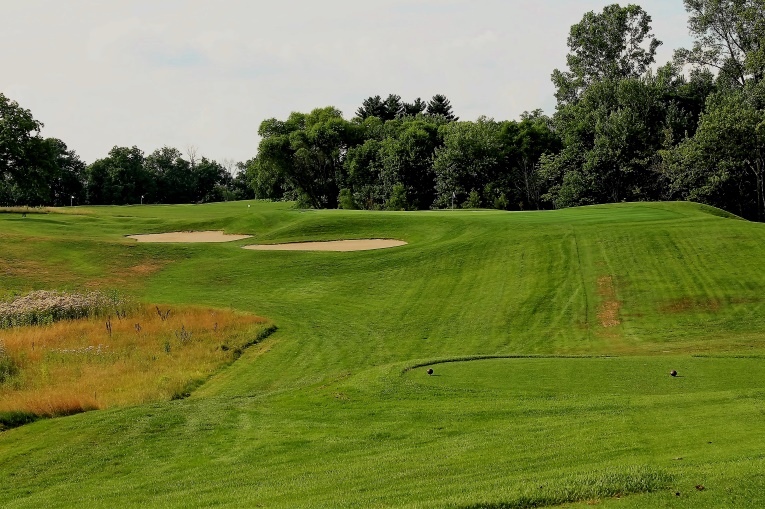
The thrilling, modified Redan at Culver was undoubtedly influenced by Chicago Golf Club’s own manufactured Redan hole, which Raynor completed several months before construction began here.

A view from the left rear reveals the size and breadth of this green pad. Where Langford & Moreau got the fill to build this up remains a mystery.

Going over the Redan is even worse than being short. Langford & Moreau’s bunkers often had rolling faces, which lends them a less manufactured look than some of Macdonald’s other disciples.
Third hole, 175 yards (8th); This one shotter exhibits the three most obvious underpinnings of the Weed restoration, namely bunker work, tree removal and the expansion of the putting surfaces back to their full, glorious dimensions. The results are evident below. As is true of most green expansions, the most vexing hole locations are reintroduced into play. One day, the golfer might try for a soft fade to hold the top back right shelf while the next, he attempts to flight a draw lower and have the ball release off the green’s spine toward the back left hole locations. Club selection can vary as much as three clubs depending on the hole location and day’s wind.

As seen from the original 2006 GolfClubAtlas profile, the 3rd green was nearly 60% smaller in size, robbed of its best hole locations, and suffering from trees that had been ill-advisedly planted behind.

Look at the transformation! Bobby Weed and Chris Monti poured over a 1939 aerial to determine exactly how to expand the greens. In this case, how far to go left was obvious but where to stop right was trickier.

The 3rd green that once measured 3,962 square feet is now 6,289, which is nearly a 60% increase in size!

The putting surface (seen from the left) was fully extended to the far back left. Courtesy of the firmer playing surfaces provided by Vessely, the hole plays as well as it looks with tee balls releasing off the green’s spine, evident above.
Fourth hole, 370 yards (9th); The most famous hole at Culver, in part because folklore has it that Walter Hagan drove the green during his exhibition match here in 1926. Alas, one reliable witness disputes that claim and maintains Hagan came up short! On a straight line Hagan would have had to carry the tee ball a full 270 yards uphill before it bounded the rest of the way onto the green. A truly great feat for someone armed with a hickory driver. For the golf architecture student, the fourth is a prime example of how to route a hole with a steep embankment used to great effect. The vertical nature of this embankment does not naturally lend itself to great golfing qualities but Langford maximized its dramatic quality by i) placing the first tee on it and ii) swinging the left half of this dogleg around it. In addition, the inside of the dogleg (the part of the fairway closest to the embankment) is itself rather steeply inclined. Though the golfer is in the fairway, the ball will be well above his feet and a pulled approach is the natural consequence. In this case, a pull is a dreaded outcome as built-up green pad falls away nine feet on the left. The right half of the fairway (the part farthest from the embankment) provides more level stances. Playing for the right side of the fairway has the effect of making this dogleg left play longer but the savvy golfer concludes that sacrificing a shorter approach shot is more than compensated for with the better stance that is afforded. One of the Midwest’s finest holes.

This kettle bowl type depression was masked by trees in 2006.

The thrilling approach from 120 yards out – anything left is death and unfortunately the stance in the sloping fairway tends to promote that very result.

Some might wonder how nine holes that measure 3,230 yards can challenge good players. The depth of the hazards and the green contours are two immediate answers. Additionally, several tee balls like the one here hit into upslopes and kill much roll. Also, given that the best angle into the 4th green and most level stances are afforded from the outside of the dogleg, the hole plays longer than its 370 yards.

The O’Neal family owns a house one mile from the course, coincidentally across the street from another nine hole Langford & Moreau course. Their daughter Alice married a golf course architect and together, Pete and Alice Dye have spent numerous summers in Culver. They speak glowingly of this course and no wonder – this bunker looks like something straight from a Pete Dye design!
Fifth hole, 490 yards (1st); A half par hole made intriguing in part by the second shot which for all but the longest hitters is blind over the shoulder of a hill. One has a reasonable hope of getting near the massive green complex in two but getting up and in is another matter. At 7,125 square feet, this is the largest green on the course and the golfer marvels as to how something so pronounced can lay so peacefully upon the ground. Part of Langford & Moreau’s success in achieving designs like Lawsonia and here that are so pleasing to the eye lies in how often they start the putting surface at grade from the fairway, with this green being a prime example. Weed expanded the green by 65%, a staggering amount but the putting surface – and its bewitching hole locations – allows the hole hold its head up high with the other eight holes. When asked if he has a favorite hole or two, Weed remarks, ‘Actually, I don’t. Every single green is so good that each hole has its own strong character, I couldn’t just pick one or two. In fact, when you consider all nine putting surfaces, and the variety found within them, they might be my favorite set of greens I have ever seen.’

A reachable three shotter, par is defended at the immense green which rises nearly 7 feet (!) from front to back.
Sixth hole, 440 yards (2nd); A spacious hole that sweeps to the right makes one wonder why more holes aren’t found like this across the Midwest. There is nothing particularly compelling or unique about the property that the hole occupies and yet there’s great beauty in how gracefully Langford draped the hole over it. For many, it’s their favorite hole on the course.
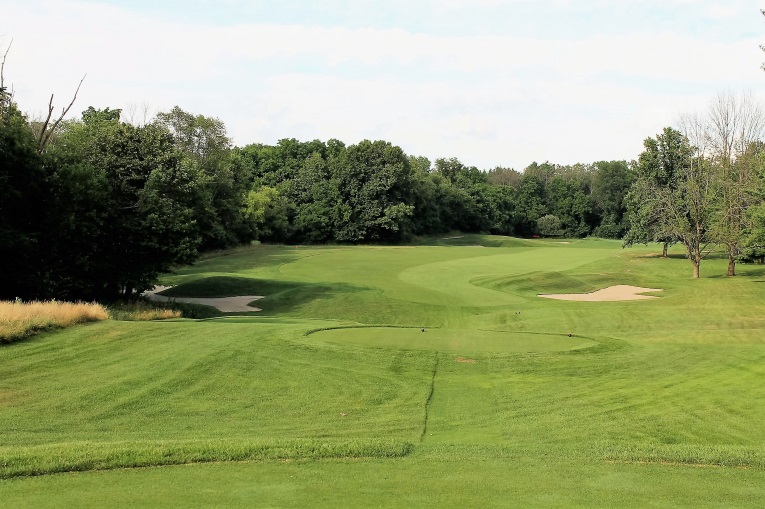
… in the afternoon, the large scale bunkers and their tall walls punctuate the terrain. There is nothing petite about this nine holer or its features.
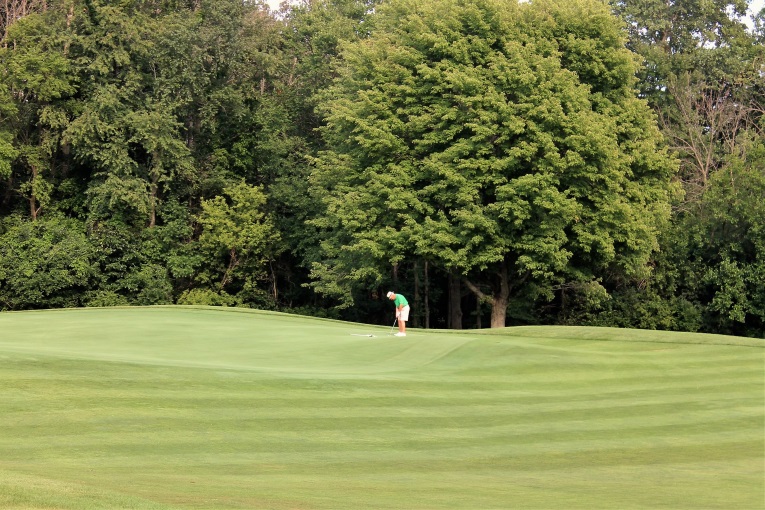
Yet, interestingly enough, no bunker is within 40 yards of the rolling putting surface. Today’s top right hole location on a small shelf is a prime example of how a large scale course can still put a premium on accuracy.
Seventh hole, 420 yards (16th); Certainly the hardest hole on the course today, just imagine what it played like in the 1920s with hickories! Architects in the Golden Age of golf design wanted to challenge the golfer by requiring him to hit every shot during a round, including sometimes a wood into a green. As usual on such holes, the green was left open in front and while uphill, the unwatered fairways gave the golfer a chance to run one on. Bryon Nelson considered this to be the best hole when he played here in July, 1943. The consummate shot-maker, Nelson also would have appreciated how a fade off the sixth tee was optimal while the architects ask for a draw here.

As seen in the 2006 and …

… the much improved version today. With the two trees removed from the inside of the dogleg, the golfer is sorely tempted to hit the required draw off the tee to bring the green within reach. Additionally, the promotion of fescue grasses completes the handsome picture, and stands in sharp contrast to the sea of green in the photograph one above.

Those that play tentatively to the right face this daunting uphill second shot. Culver has come to the realization that a golf course is a living, breathing thing; it is not static. In particular, trees and underbrush will forever intrude and compromise playing lines if not properly managed. The dead ash tree above was being removed shortly after this photograph was taken. As vigilant practices are reestablished and clearing occurs, the hearty fescue grasses long dormant are flourishing.
Eighth hole, 170 yards (17th); A highly original one shotter, the downhill eighth features the course’s deepest green, which is narrow in front before broadening toward the back with bunkers on either side. The front third of the green slopes away from the golfer, consistent with the fall of the land on this downhill hole and of course that’s where the most exasperating hole locations are found. Yet, such hole locations didn’t exist just three years ago, as can be discerned below. Trying to drop one’s tee ball onto the front (narrow) part of the green is tantalizing, though a slight pull or push results in a deep bunker shot that can be easily ping-ponged back and forth across the green.

The morning dew helps capture the size of the green, which is 42 yards deep. Though all the par 3s measure between 170 and 180 yards, changes in elevation, hole direction and the varied possibilities for hole locations help make them play far different than the yardages suggest.

It is amazing how in just eighteen months Vessely has seamlessly tied in the reclaimed putting surfaces with the original bent greens. Weed deems Vessely’s work ‘phenomenal.’ Looking back toward the tee, this golfer would have been ~ 10 paces off the green based on …

… this 2006 photograph taken in the other direction!
Ninth hole, 480 yards (18th); For a course built more than ninety years ago and considering that the Langford tee boxes have never been stretched, the Culver course retains an amazingly high degree of ‘pleasurable difficulty’ to this very day, thanks to the bold characteristics of the property and the stout-hearted features that Langford built. More than any other hole, the ninth had lost much of its teeth with the removal of several dominate central bunkers. No longer! Big hitters must now contend with their tee balls running into a pair of bunkers – pits really – that likely preclude reaching the green in two.

The nine holes that were built effortlessly bounce in and out of different environments. Above, the ninth tee shot plays out of the 5 acres of dense trees that the golfer enters into with his approach to the 7th.

In the fairway in 2006, today this golfer would be in the middle of …

Once the golfer crests the hill from the tee, this thrilling view opens up. The new, well proportioned Golf House in the background is entering the final stages of construction.
Only after the round does the golfer appreciate that he has just played three one shot holes, three two shot holes, and three three shot holes. More importantly, there isn’t an indifferent hole in the bunch. Every club will be tested, including the tiger’s long irons when he attempts to reach the par 5s in two after good drives. To the author, it is literally a perfect nine holes. The only comparable nine would be The Sacred Nine at Royal Worlington & Newmarket in England. Coincidentally, that course is also tied to academic excellence, given its relationship with Cambridge University.
Yet, to merely describe this course in the context of other nine holers is an injustice. Indeed, perhaps only thirty or forty eighteen hole courses in North America have as many inspired holes as the nine at Culver Academies Golf Course. Think about that. The statement is not as outrageous as it seems when one considers that the initial opportunity here was truly of exception. A supremely talented architecture team was given 250 acres with which to work. The nine holes that were built occupy the most exhilarating portion of that land. Its location by Lake Maxinkuckee means that the crucial element of wind is always present. Throw in Langford’s routing and the unshrinking features that they built, and golfer will conclude like the author that this is one of the finest collection of golf holes that he has had the pleasure to play.
Importantly, the school is once again fully committed to the course. This is as it should be for Culver Academies stands for excellence in all pursuits, all the time. It wholeheartedly offers crew, equestrian pursuits, hockey and tennis. How can you attract the best without offering the best?

The parade ground in front with the equestrian center behind, which features one of the world’s largest indoor riding arenas and 80 stalls for the school’s horses.
Rounding out the golf facility is a putting/chipping green that was installed between holes four and nine, along one of the high points on the property. Beyond that is a full scale practice field and Culver has programs designed to interest novices in the game. Golf is again on equal footing with the school’s other top-draw offerings, all of which was made possible by the support from its alumni who paid for the restoration.
Best yet, the school’s current leadership understands and respects the history of the game. No golf cart paths mar the tumbling terrain. What a delightful place for the students to learn our cherished sport, with a bags slung over their shoulders. It is certainly one of the quietest courses in the world upon which to enjoy a game. Wildlife roam and the silence is broken only by the church bells on the hour or the sounds of students enjoying other outdoor pursuits.
If a student doesn’t fall in love with the game here, then golf is not meant for him or her. The rest of the students and alumni can content themselves with playing golf on the finest course in the Hoosier state.
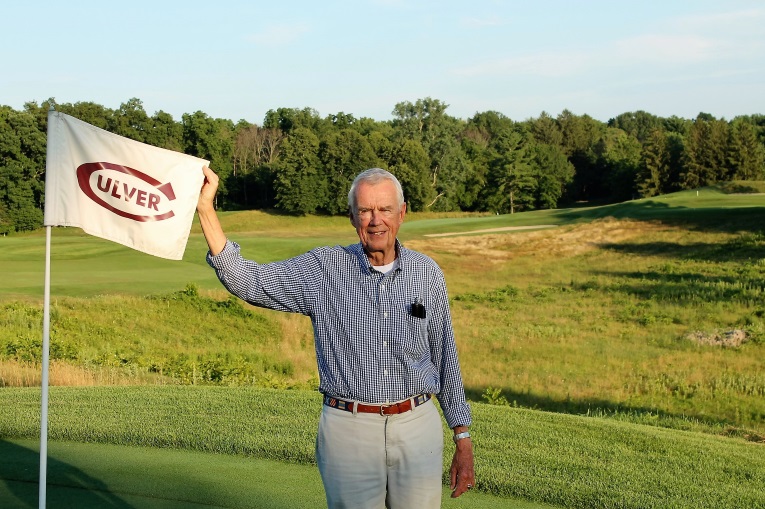
Jim Henderson and the entire school family have every reason to be thrilled and proud of their golf course once again.
The End


